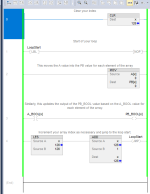A 2D BOOL array would nicely match to representing a 2D grid of rectangles with 2 possible colors.
Unfortunately, RSLogix does not support 2D BOOL arrays so that's a non-starter for this particular assignment.
One thing I think may be being overlooked -- what is the data type of the PB[0-127] and A[0-127] tags? Does the assignment specify? Pushbuttons and rectangle objects would normally deal in bools and the [] format suggests an array in which case drbitboy's suggestion of COP/CPS should be sufficient, no indirection necessary (even if his signature suggests otherwise).
On the other hand the OP asked "how do I connect the DINTs specifically" -- where do DINTs come into it at all?
EDIT: Since OP has stated this is for a game of battleship, it seems clear to me that the original post led some of us a little astray. From the sounds of it, the player will push a button (somehow mapped to PB[...]) and the corresponding tile A[...] will change color -- "turn grey" -- to indicate it was fired at (or perhaps turn a different color to indicate a hit, but that's an issue to deal with later). In Battleship you want the tiles fired upon to stay marked until the end of the game, so a COP/CPS is not sufficient, instead a loop using latches will be necessary.



